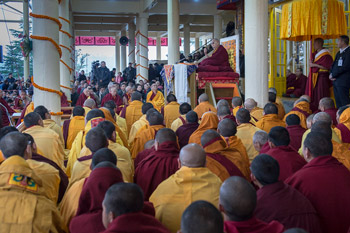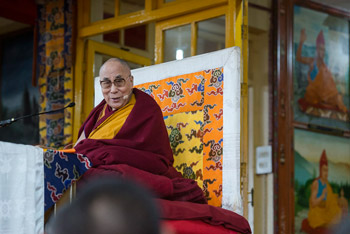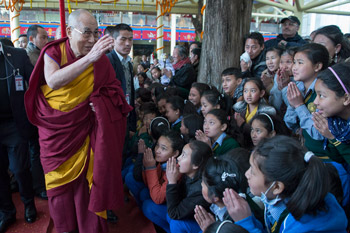Dharamsala, HP, India, 5 March 2015 - Since it was the 15th day of the first Tibetan month, the full moon day, early this morning His Holiness the Dalai Lama joined the assembled monks and nuns in the Tsuglagkhang at Thekchen Chöling for the bi-monthly Sojong or ‘restoration and purification’ ceremony. At about 8 o’clock he was escorted down to the courtyard in front of the temple, beneath a ceremonial golden umbrella. While most of the monks and nuns stayed upstairs in the temple, where they could follow the proceedings on a video feed, the temple courtyard was packed with lay-people; Tibetans and visitors from many parts of the world.

|
His Holiness the Dalai Lama speaking at the Tsuglagkhang on the final day of the Great Prayer Festival in Dharamsala, HP, India on March 5, 2015. Photo/Tenzin Choejor/OHHDL
|
After reciting verses of homage to the Buddha, Maitreya, Nagarjuna, Atisha and the lineage gurus, His Holiness began:
“This Great Prayer Festival, which is held at this time every year, was established by Je Tsongkhapa in 1409. Although there have been times when we couldn’t observe it, in 1959, we escaped to India after the festival had taken place in Lhasa. Once in exile we were able to revive it. It reminds us of the Buddha’s great deeds in India. Today in particular we remember the occasion when he defeated six proponents of other doctrines in a display of miracles at Shravasti. There is also a tradition of recalling his deeds in lives prior to his becoming a Buddha, during his career as a bodhisattva, by reading from the Jataka Tales.”
His Holiness mentioned that the Jatakamala and the Tibetan equivalent of the Dhammapada, the Udanavarga, were among the six principal texts of the Kadampa tradition founded by Dromtonpa. These also included Shantideva's ‘Guide to the Bodhisattva's Way of Life' and ‘Compendium of Training', Asanga's ‘Bodhisattva Grounds' and Maitreya's ‘Ornament of Sutras'. He suggested we take inspiration from the bodhisattva’s conduct as related in the Jataka tales.

|
A view of the temple courtyard filled with thousands attending His Holiness the Dalai Lama's teaching on the final day of the Great Prayer Festival in Dharamsala, HP, India on March 5, 2015. Photo/Tenzin Choejor/OHHDL
|
“For a Buddhist teaching to become a Buddhist practice,” His Holiness advised, “we need to cultivate a good motivation, such as the wish to become enlightened to be able to help all sentient beings. With such a motive, our recitation of prayers and mantras and whatever else we do will be a Buddhist practice. Here in the twenty-first century we place great value on education. As Buddhists we need to be curious and sceptical. We need intelligence and logical analysis. On that basis our faith will be based on reason and we’ll develop a wish to be free of cyclic existence and to become enlightened for the sake of other beings.”
His Holiness quoted the Buddha as saying that his followers should not take his words for granted because he said them. They should check them, analyse his teaching as a goldsmith tests gold. His Holiness pointed out that while great beings founded other religious traditions, none of them encouraged their followers to question and verify their teachings the way the Buddha did.
His Holiness remarked that Tibetan Buddhism as a whole is part of the Nalanda tradition, that Nalanda was the source of Buddhism in Tibet the way a spring in the mountains is the source of a river. He said all the Buddhist traditions in Tibet, and even the Bön tradition today, trace back to Nalanda. He said Tibetans follow the this tradition not only in name, but in closely studying and comparing the works of the great masters from Nalanda University. Since Tibetan masters later compiled books of tenets, Tibetans became well-versed in the different philosophical points of view propounded by these masters.

|
| His Holiness the Dalai Lama speaking at the Tsuglagkhang on the final day of the Great Prayer Festival in Dharamsala, HP, India on March 5, 2015. Photo/Tenzin Choejor/OHHDL |
“We have to examine whether an instruction is beneficial and if we conclude that it is helpful, cultivate it,” he advised. “The Dharma implies something that saves us from suffering, something that holds us back from suffering. It consists of corrective measures we can take to effect transformation within ourselves.”
He explained that as human beings we have minds that enable us to think. Animals largely depend on their five senses, but don’t think very much, whereas neuroscientists today suggest that we have far from fully explored the potential of the human brain. On the other hand it can work against us. His Holiness cited cases he has met of people who have everything they could want on a material level, who nevertheless remain unhappy. Animals that are not in obvious danger are generally quite relaxed compared to human beings caught up in preconceptions and projections that disturb their peace of mind. He suggested we use our marvellous potential to create happiness instead.
As social animals we need love and affection from birth to survive. We are interdependent; we rely on others throughout our lives. If we show love and affection to others and help them, we help ourselves. Being honest and good-hearted brings trust and trust brings friends.
“All our religious traditions,” His Holiness observed, “teach love, compassion, tolerance and self-discipline. I have many Christian, Muslim, Jewish and Hindu friends who are dedicated to helping others and living in contentment. This much they share, while they differ in their philosophical views. I admire the idea that having been created by a God who embodies infinite love, we have a spark, an inspiration to show others love ourselves. The Buddha, on the other hand, said that what happens is up to us. If we help others, we create happiness. If we do harm the result is suffering.”

|
A Tibetan monk listening to His Holiness the Dalai Lama speaking on the final day of the Great Prayer Festival in Dharamsala, HP, India on March 5, 2015. Photo/Tenzin Choejor/OHHDL
|
His Holiness went on to discuss the 16 attributes of the Four Noble Truths and the Twelve Links of Dependent Origination. He concluded that the Buddhist philosophical view can be summarized as dependent origination, while Buddhist conduct is non-violence; to avoid doing harm. To understand this requires study.
The reading of the Jataka Tales during the Great Prayer Festival had yesterday reached the Thirtieth tale. Today, His Holiness read from the Thirty-first concerning a Prince who with great courage overcomes an evil being. It ended with the King, the Prince’s father, concluding that his son had the requisite clarity, humility and compassion for others to rule the kingdom and confirming him as his heir.
His Holiness then led the assembly in a short ceremony for generating the awakening mind of bodhichitta based on the common verse:
I go for refuge until I am enlightened
To the Buddha, the Dharma and the Highest Assembly
Due to the collection of merits accumulated by me and by others,
May I achieve enlightenment to benefit all sentient beings.
In conclusion he remarked:

|
His Holiness the Dalai Lama waving to members of the crowd as he returns to his residence at the conclusion of his teaching on the final day of the Great Prayer Festival in Dharamsala, HP, India on March 5, 2015. Photo/Tenzin Choejor/OHHDL
|
“Just as we rely on food and drink to survive, we need to recall bodhichitta in order to become a Buddha. If you recite this verse regularly it will make your practice effective.
“Those of you who have come from Tibet, others who are still there and Chinese Buddhists, remember that it’s good to recite the mantras of Shakyamuni Buddha, Chenrezig, Tara, Guru Rinpoche and the Seven Line Prayer to him, the Praise to the Twenty-one Taras and Dependent Arising: A Praise of the Buddha by Je Tsongkhapa.”
Formal prayers of dedication were chanted and His Holiness returned to his residence. 